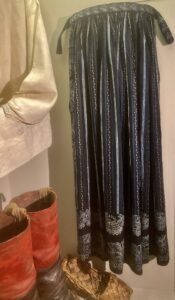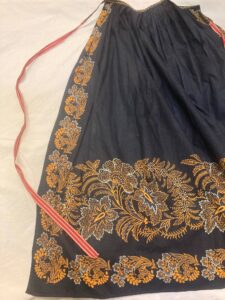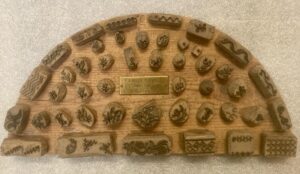Research Note: Seeking blue aprons and their Mennonite Blaufärber
As part of commemorating the 150th anniversary of Mennonites from South Russia immigrating to the North American plains, Kauffman Museum at Bethel College in North Newton, Kan., has launched the Indigo Textile Project to research the blue resist-dyed aprons brought by some Mennonite women beginning in 1874.
Kauffman Museum’s permanent exhibit features this indigo blue-and-white print apron that belonged to Sarah (Abrahams) Janzen Heinrichs Kliewer, who emigrated in 1874 from Alexanderkrone in the Molotschna Colony to Henderson, Neb.

Apron/Schürze donated by Emil Friesen to Kauffman Museum, KM 6547.1 (photo by David Kreider)
Other aprons at Kauffman Museum lack family or origin information, such as this indigo blue apron with chrome orange and white patterns.

Apron/Schürze from unknown donor to Kauffman Museum, KM 6508.11 (photo by David Kreider)
Two Kansas collections hold blue and white tablecloths from Mennonite families who emigrated from South Russia in the 1870s.

Tablecloth/Tischdecke from the Peter and Katharina (Unruh) Voth Family, Mennonite Heritage and Agricultural Museum, Goessel, Kan. (photo by Kris Schmucker)
The apron designs are created by block printing a resist paste onto the fabric that is then immersed in indigo dye. Resist-printed areas remain white or, if the paste contains a mineral additive, a highlight color such as chrome orange. In German, this resist-dye process is called Blaudruck – literally blue-print – and the craftsman dyer Blaufärber.
Kauffman Museum holds a collection of printing block designs created with brass pins and strips hammered into hardwood. Traditionally this technique (Formstechen) and the older craft of carving design motifs from a wood block (Formschneiden) were separate from the work of the blue-dyer/printer. I have not located any printing blocks, but found that Franz Voth, a Chortitza colony master blue-dyer, was knowledgeable about Formstechen (Dyck 2020, 71, 79).

Sampler of blue-printing “stamps,” C.J. Claassen Collection, KM 90.33.1 (photo by David Kreider)
While the history of Mennonite craftsmen deserves deeper study, there is preliminary evidence of South Russian Mennonites who were Blaufärber or who had a blue-dyeing and printing business (Blaufärberei und druckerei).
Blue-dyers and blue-printers, Chortitza & Molotschna, 19th- to early 20th-century
| Name (birth-death) | Year/s known to be active | Connection to blue-dyeing and blue-printing (source of information) | Village and colony |
| Bestvater, Jakob (1856-1913) | 1908 | “dyed cloth blue in his business” (Huebert 2003, 145); Blaufärberei (Vogt n.d., 80) | Ladekopp, Molotschna |
| Fast, Kornelius Martin (1860-1920) | 1912-14 | Blaufärberei (Vogt n.d., 70) | Blumstein, Molotschna |
| Janzen, Heinrich
(dates unknown) |
unknown | Blaufärber (Funk 1904, 1) | Lichtfelde, Molotschna |
| Martens, Jakob (dates unknown) | unknown | Blaufärber (Quiring 1900, 5) | Schönau, Molotschna |
| Schellenberg, Abraham (1845-1920) | before emigration in 1879 | “tablecloth was woven and dyed…in his own dye works” (Goertzen, 2024) | Tiege, Molotschna |
| Thiessen, Jakob (1832-1906) | 1863 | “a larger dyer in blue establishment and a print shop” (Friesen 1974, 36; original Blaufärberei und druckerei) | Schönau, Molotschna |
| Thiessen, Jakob J. (1857-1935) | 1908 | Blaufärberei (Vogt n.d., 88) | Schönau, Molotschna |
| Voth, Franz (1805-69) | 1837 | “one of the most capable ‘blue dyers’ and print masters” (Dyck 2020, 79) | Einlage, Chortitza |
| Woelk, Abraham (1840-1900) | unknown | “‘Blaufaerber’ and owned a print shop” (GRanDMA #63483) or worker, possibly bookkeeper, for foster father Jakob Thiessen (Family Record 95, frame 053) | location unknown or Schönau, Molotschna |
The Indigo Textile Project continues to seek Mennonite examples of:
- indigo aprons and tablecloths
- blue-dyers/printers and printing block craftsmen – additions and corrections
- printing blocks, resist-paste recipes, pattern books or descriptions of blue-dyeing and printing
- drawings or photographs of women wearing indigo aprons
Kauffman Museum invites you to join in recovering the history of indigo textiles with the goal of exploring the meaning of these aprons and the role of artisan dyers in the Mennonite colonies.
Sources
Dyck, Harvey L., Ingrid I. Epp, and John R. Staples (eds.). 2020. Transformation on the Southern Ukrainian Steppe: Letters and Papers of Johann Cornies, Volume II, 1836-1842, translated by Ingrid I. Epp. Toronto: University of Toronto Press. https://tspace.library.utoronto.ca/handle/1807/100164
Family Records of Alexanderwohl Families: Schmidt, Friesen, Woelk, Duerksen. Microfilm MF MSS 48, Mennonite Library and Archives, Bethel College.
Friesen, Heinrich B. 1974. The Autobiography of H.B. Friesen 1837-1926. Newton, Kansas: n.p.
Funk, Jakob. 1904. “Aus dem bewegten Leben des Bruder Jakob Funk.” Mennonitische Rundschau 27, no. 23 (06-01): 1-2. https://archive.org/details/sim_die-mennonitische-rundschau_1904-06-01_27_23/mode/2up?q=Blaufarber&view=theater
Goertzen, Peggy. March 7, 2024. Email message to author from Center for Mennonite Brethren Studies–Tabor College.
GRanDMA OnLine 7. Prussian/Russian Mennonite Genealogy. Abraham Woelk #63483. https://grandmaonline.org/
Huebert, Helmut T. 2003. Molotschna Historical Atlas. Winnipeg: Springfield. https://archive.org/details/MolotschnaHistoricalAtlasOCRopt
Quiring, Peter and Anna. 1900. “Henderson, York County.” Mennonitische Rundschau 21, no. 10 (03-07): 2, 5. https://archive.org/details/sim_die-mennonitische-rundschau_1900-03-07_21_10/page/2/mode/2up?q=Blaufarber&view=theater
Vogt, Willi. n.d. Liste der mennonitischen Industrie- und Handelsunternehmen in Russland. https://media.chortitza.org/pdf/Pis/Indust.pdf
